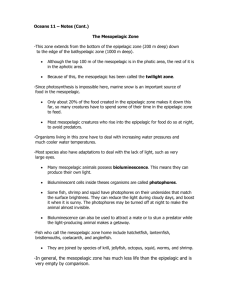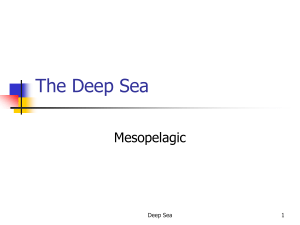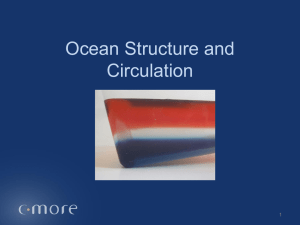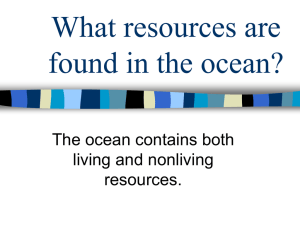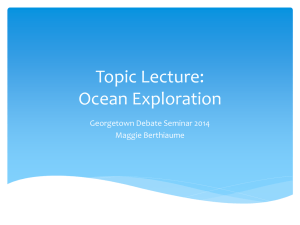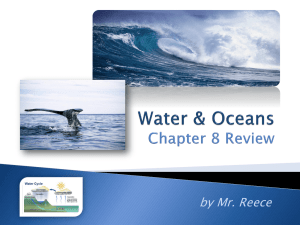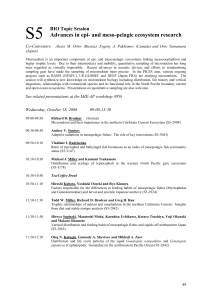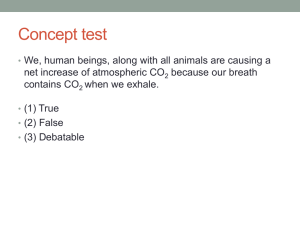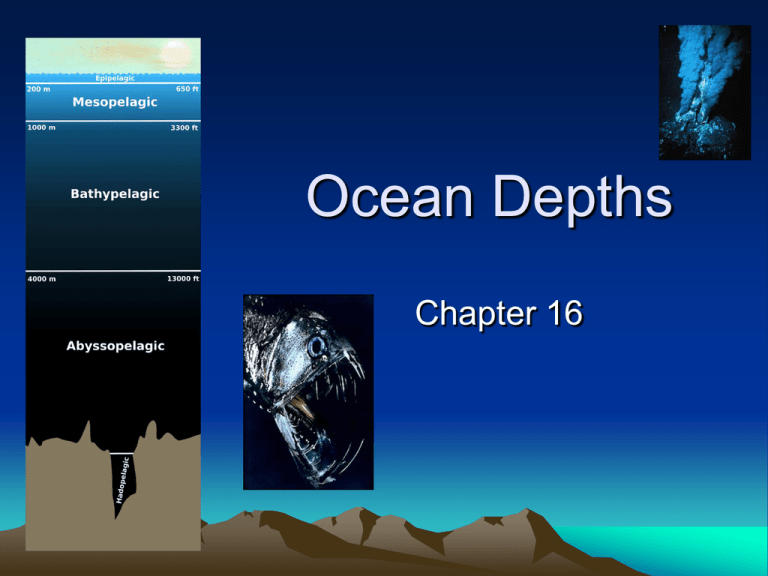
Ocean Depths
Chapter 16
The Ocean Depths
• “Inner space” it has been called. Dark and
cold, inhabited by bizarre, fearsome
looking creatures, it is a little reminiscent
of the outer space of science fictions
movies.
• Tremendous pressures, perpetual
darkness
• This is the Deep ocean
Oceanic Zonation – upper layers
• The ocean depths include a number of distinct
habitats
• The uppermost layer is the epipelagic zone.
This is roughly equivalent to the photic zone.
(surface – 200 m)
• Beneath the epipelagic is the mesopelagic
zone – or the middle pelagic – light still
penetrates, but not enough for primary
productivity. This layer is sometimes called the
twilight zone (200 m – 1000 m)
Oceanic Zonation – lower layers
• Beneath the upper layers of the epipelagic and the
mesopelagic we find the lower layers of the ocean – truly the
deep ocean
• The bathypelagic zone (1000 m – 4000 m ~ 2.5 miles) is a
world of perpetual darkness
• The conditions of life in the deep pelagic environment change
very little. Not only is it always dark, it is always cold: 35
degrees F……salinity 35 ppt.
• Below the bathypelagic there is the abyssopelagic zone
(4000 m – 6000 m ~ 4+ miles)
• Below the abyssopelagic zone exists the deepest locations on
earth, the hadopelagic zone (6000 m – 11000 m ~ 4+ to 7
miles)
• The deepest place on earth is at the Mariana Trench;
Challenger Deep in the Pacific ocean (10,991 m / 36,061 ft)
• Mt. Everest by comparison – the highest point on earth, has a
height of 29,035 ft.
Mariana Trench:
Challenger Deep in the
Pacific ocean 10,991 m
/ 36,061 ft
Trieste
Topography and Bathymetry
Oceanic Zonation
Life Down Below
• Deep-water organisms depend on the surface
not only for food, but also for oxygen. If the
ocean were stagnant, the oxygen below the
surface would quickly be depleted by
respiration and animal life.
• The thermohaline circulation / the great ocean
conveyer constantly replenish the supply of
oxygen to the deep sea
• Oxygen still becomes depleted in some places
though
Oxygen Minimum Zone (OMZ)
• In many places, mid-water organisms
have to deal with a shortage of oxygen in
the water
• Oxygen enters the water in two ways:
– Gas exchange with atmosphere (dissolved
gasses)
– Photosynthesis
• OMZ – 500 m
The oxygen
minimum zone:
~ 500 m
Animals of the Mesopelagic
• Photosynthetic organisms cannot exist in
the mesopelagic – too dark to total
darkness
• Zooplankton (Krill and copepods, shrimps)
• Squids, octopus, fish (usually small)
• Common adaptation of mid-water animals
– Photophores ~ light organs
– bioluminescence
Some typical deep sea bottom fish
Sense Organs
• To help them see in the dim light, midwater fishes characteristically have eyes
that are not only large, but unusually
sensitive.
• Large, light-sensitive eyes also occur in
squids, shrimps, and other groups
• Some mid-water fish have developed
tubular eyes, a complex visual system
that is almost like having two pairs of eyes
Photophores
Barreleye (Macropinna microstoma)
~ 800 m
Clear
forehead
Tubular eyes
capped by green
lenses
nostrils
Bioluminescence
• Most midwater animals have evolved an
even more effective way to mask their
silhouettes.
• Their bioluminescent photophores,
found mostly on their ventral side, produce
light that breaks up the silhouette and
helps the animal blend in with the
background light filtering down from the
surface: counter illumination.
Counterillumination
Photophore arrangement
Matching background light intensity
Giant deep sea amphipod
Sex in the Deep Sea
• Food is not the only thing that is scarce in the
deep sea
• In such a vast, sparsely populated habitat,
finding a mate can be difficult
–
–
–
–
Hermaphrodites
Bioluminescence
Pheromones
Male parasitism (anglerfishes ~ Cryptopsaras
Ceratias)
• Male bites into much larger female, male’s modified jaws
fuse with the female’s tissue. Their circulatory systems join,
female nourishes the male
Male Parasitism (The Anglerfish)
Hydrothermal vent system
Hydrothermal vent communities are based
on chemosynthetic prokaryotic organisms
Anatomy of
giant
tubeworm:
The
chemosynthetic
symbiosis
Reflection
• So…….animals called corals share a mutalistic symbiotic
relationship with zooxanthellate dinoflagellate protists in which they
utilize each others byproducts
• And here we have animals – tubeworms, fish, crustaceans,
mollusks, etc. – sharing a mutualistic symbiotic relationship with
extremophile archaebacteria in which they utilize each others
byproducts……
• Amazing……
• Light energy + photosynthetic protist + animal = incredibly beautiful
marine life in otherwise nutrient poor environments
• Inorganic and thermal energy + chemosynthetic prokaryotes +
animal = incredibly strange marine life in an otherwise extremely
cold, dark, highly pressurized, and desolate place
The end

